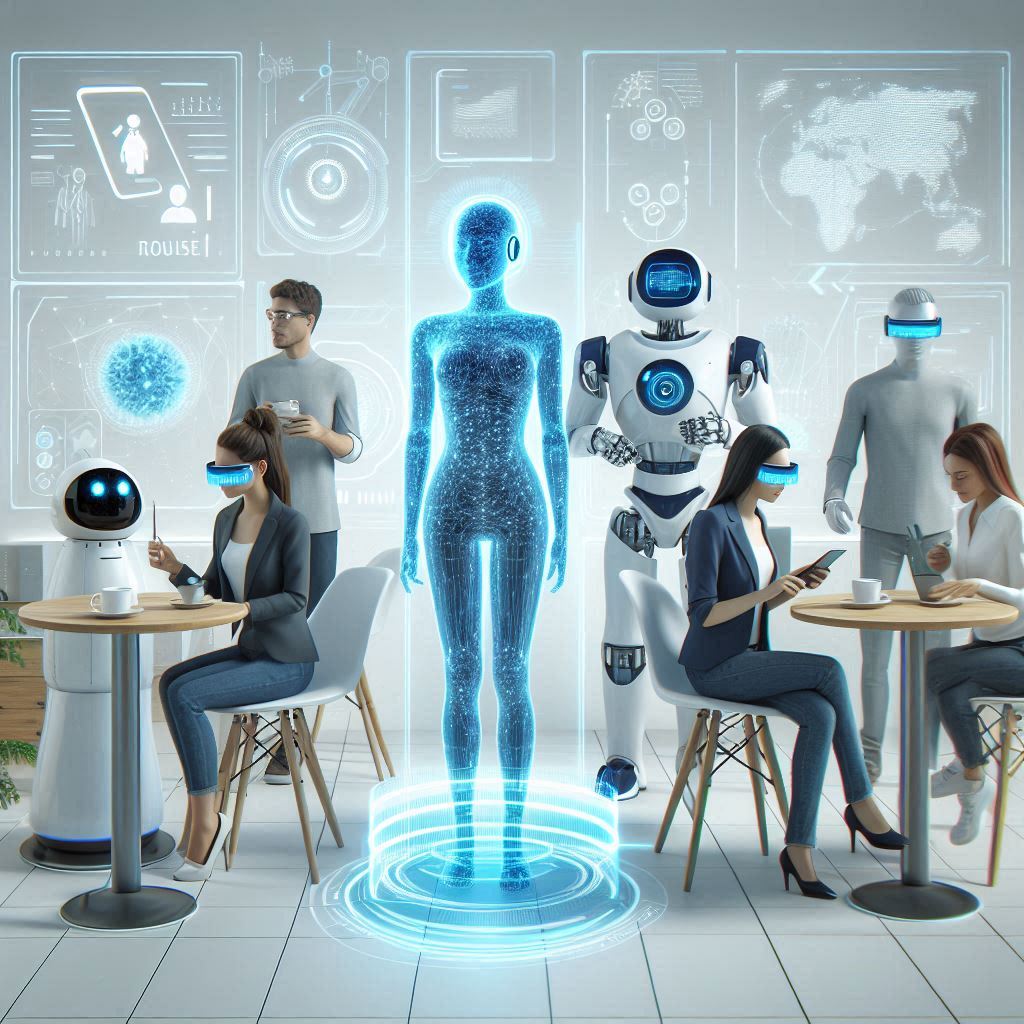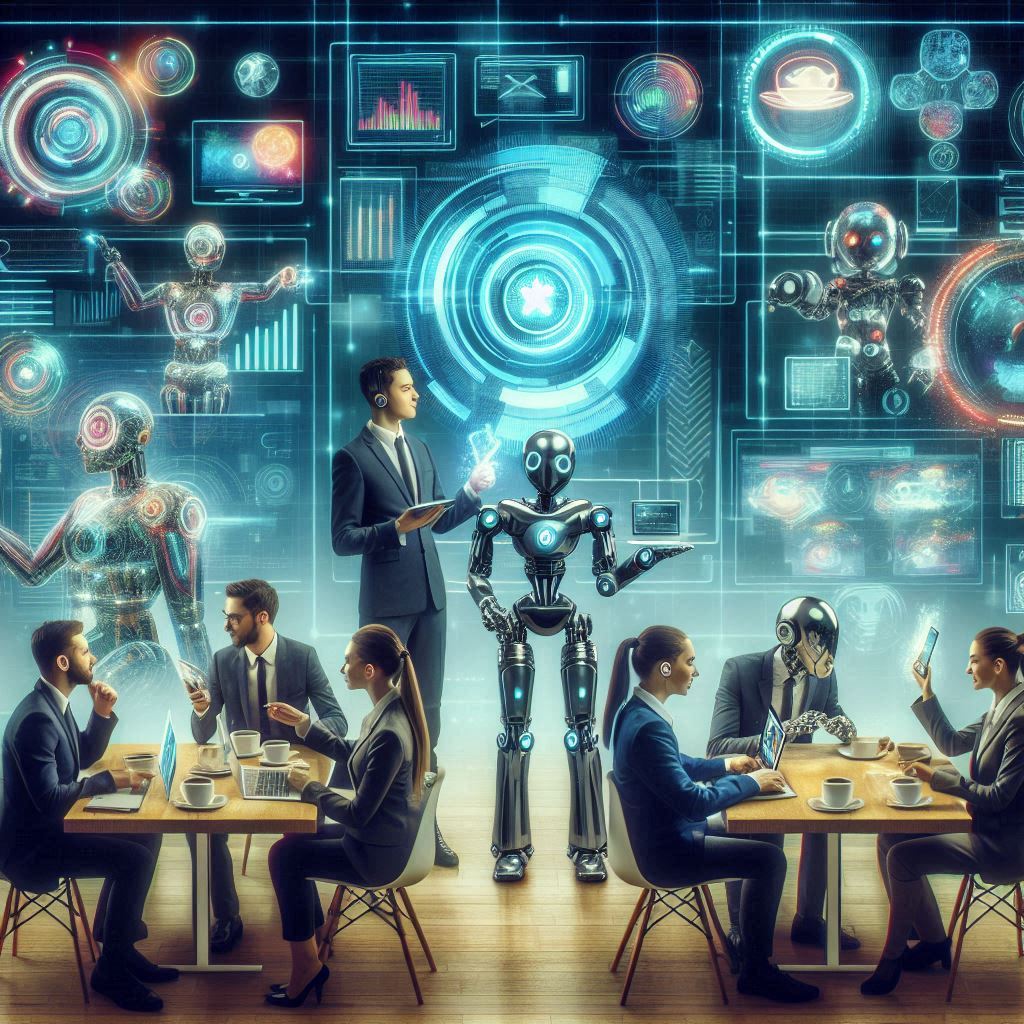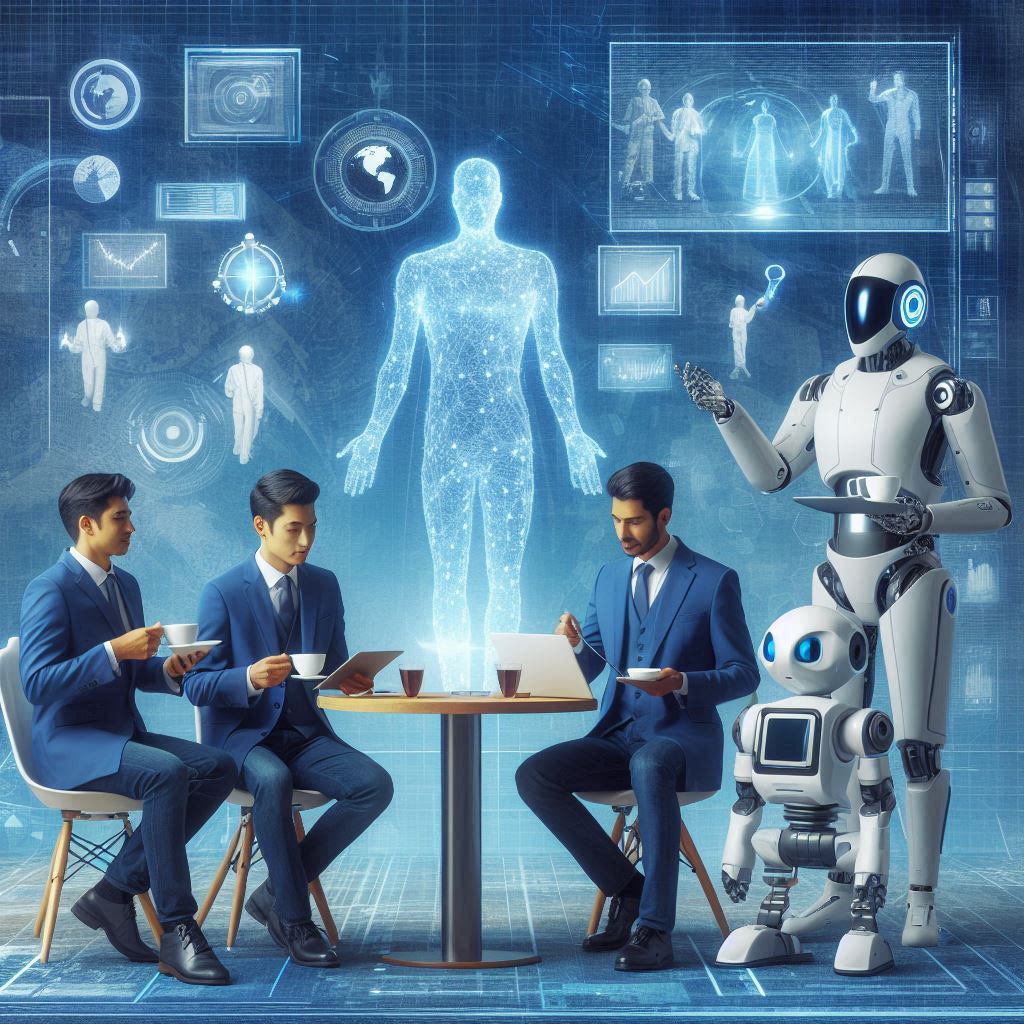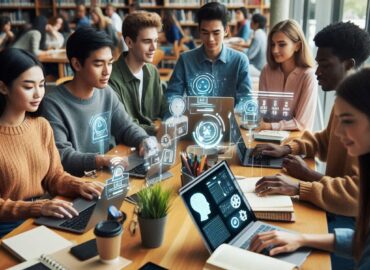4th Industrial Revolution and Unlocking Boundless Opportunities
In the grand tapestry of human history, certain periods stand out as transformative epochs, altering the very fabric of society and reshaping the way we live, work, and interact. The 4th Industrial Revolution is one such epoch, characterized by the fusion of technologies blurring the lines between physical, digital, and biological realms. From artificial intelligence and robotics to the Internet of Things (IoT) and biotechnology, this revolution is not just changing industries but fundamentally altering the way we perceive and engage with the world around us.
The 4th Industrial Revolution, often abbreviated as 4IR, refers to the ongoing transformation of traditional industries through technological advancements like artificial intelligence, robotics, the Internet of Things (IoT), 3D printing, nanotechnology, biotechnology, and more. This revolution is characterized by the fusion of digital, physical, and biological systems, leading to unprecedented levels of automation, connectivity, and efficiency across various sectors.
Key elements of the 4th Industrial Revolution include:
- Artificial Intelligence and Machine Learning: AI algorithms are becoming increasingly sophisticated, enabling machines to learn from data, recognize patterns, and make decisions with minimal human intervention.
- Internet of Things (IoT): IoT involves connecting everyday objects to the internet, allowing them to send and receive data. This connectivity enables smart devices, smart homes, and smart cities, leading to improved efficiency and convenience.
- Robotics and Automation: Robotics technologies are advancing rapidly, with robots taking on increasingly complex tasks in manufacturing, healthcare, agriculture, and other industries. Automation streamlines processes, reduces costs, and enhances productivity.
- 3D Printing: Also known as additive manufacturing, 3D printing enables the creation of three-dimensional objects by depositing materials layer by layer. This technology has diverse applications, including rapid prototyping, custom manufacturing, and even medical implants.
- Biotechnology and Genomics: Breakthroughs in biotechnology, such as gene editing and synthetic biology, are revolutionizing healthcare, agriculture, and environmental conservation. These advances hold promise for personalized medicine, sustainable food production, and combating diseases.
- Blockchain Technology: Blockchain offers secure and transparent peer-to-peer transactions, with applications ranging from cryptocurrency to supply chain management and digital identity verification.
- Augmented Reality (AR) and Virtual Reality (VR): AR and VR technologies overlay digital information onto the physical world or create immersive virtual environments. They are used in gaming, education, training, and various industrial applications.
The 4th Industrial Revolution is reshaping economies, societies, and workforces worldwide. While it presents numerous opportunities for innovation and growth, it also poses challenges, such as job displacement due to automation, ethical considerations surrounding AI, and concerns about data privacy and security. Successful adaptation to the 4th Industrial Revolution requires proactive efforts in education, workforce development, regulation, and ethical governance.
Understanding the 4th Industrial Revolution
The term “4th Industrial Revolution” was coined by Klaus Schwab, founder and executive chairman of the World Economic Forum, to describe the rapid advancements in technology that are disrupting almost every industry. Unlike previous revolutions, which were characterized by distinct periods of innovation—such as the use of steam power in the first, electricity in the second, and computers in the third—the 4th Industrial Revolution is marked by the convergence of multiple technologies, amplifying their impact exponentially.
Key Technologies Driving the Revolution
- Artificial Intelligence (AI) and Machine Learning: AI systems, powered by machine learning algorithms, are capable of analyzing vast amounts of data, learning from patterns, and making autonomous decisions. From virtual assistants to autonomous vehicles, AI is revolutionizing various sectors, enhancing efficiency, and enabling new capabilities. AI algorithms are enabling machines to learn, reason, and make decisions autonomously. From virtual assistants to predictive analytics, AI is driving innovation across various sectors, revolutionizing everything from healthcare to finance.
- Internet of Things (IoT): IoT refers to the network of interconnected devices embedded with sensors and software, enabling them to collect and exchange data. This technology has transformed industries like healthcare, manufacturing, and agriculture, enabling real-time monitoring, predictive maintenance, and enhanced automation.
- Robotics and Automation: Robots are becoming increasingly sophisticated, capable of performing a wide range of tasks with precision and efficiency. Automation is revolutionizing industries such as manufacturing, logistics, and healthcare, streamlining processes and driving productivity gains. Robots are no longer confined to factory floors; they are increasingly becoming integral parts of our daily lives. Collaborative robots (cobots) are working alongside humans in manufacturing, while humanoid robots are assisting in healthcare, hospitality, and even customer service.
- 3D Printing: Additive manufacturing, or 3D printing, is transforming the way we design and produce objects. From rapid prototyping to custom manufacturing, 3D printing is enabling unprecedented levels of customization and flexibility, while also reducing waste and carbon emissions.
- Blockchain Technology: Blockchain offers a decentralized and secure platform for peer-to-peer transactions, with applications ranging from cryptocurrency to supply chain management. Its transparent and tamper-proof nature is revolutionizing industries, enhancing trust and efficiency in digital transactions.
- Biotechnology: Advances in biotechnology, including gene editing, synthetic biology, and personalized medicine, are revolutionizing healthcare, agriculture, and environmental sustainability. From CRISPR-Cas9 to mRNA vaccines, these innovations hold the promise of addressing some of the most pressing challenges facing humanity.
Implications and Challenges
While the 4th Industrial Revolution presents unprecedented opportunities for innovation and growth, it also brings forth a host of challenges and concerns that must be addressed:
- Disruption of Industries: Traditional industries are being disrupted, leading to job displacement and economic upheaval. It is imperative to reskill and upskill the workforce to thrive in the digital economy.
- Data Privacy and Security: With the proliferation of data-driven technologies, concerns about data privacy and cybersecurity are more significant than ever. Safeguarding sensitive information and ensuring ethical use of data are paramount.
- Ethical Considerations: AI algorithms and autonomous systems raise ethical questions regarding bias, accountability, and decision-making. It is crucial to establish ethical frameworks and regulations to govern the development and deployment of these technologies.
- Growing Socioeconomic Disparities: The benefits of the 4th Industrial Revolution are not distributed equally, exacerbating socioeconomic disparities. Addressing issues of digital divide and ensuring inclusive growth are essential for building a more equitable society.
Embracing Innovation for a Sustainable Future with 4th Industrial Revolution
Despite the challenges, the 4th Industrial Revolution holds immense potential to address global challenges and create a more sustainable and prosperous future. To harness the power of innovation effectively, it is essential to:
- Foster a Culture of Lifelong Learning: Promote education and training programs that equip individuals with the skills needed to thrive in the digital age.
- Foster Collaboration: Encourage collaboration between government, industry, academia, and civil society to drive innovation and address societal challenges.
- Embrace Responsible Innovation: Prioritize ethical considerations, sustainability, and inclusivity in the development and deployment of emerging technologies.
- Empower Individuals and Communities: Ensure that the benefits of technological advancements are accessible to all, empowering individuals and communities to participate in and benefit from the digital economy.

Healthcare:
- Precision Medicine: Advances in genomics, coupled with big data analytics, are enabling personalized healthcare tailored to individual genetic makeup and lifestyle factors. This approach allows for more accurate diagnoses, targeted treatments, and improved patient outcomes.
- Telemedicine: The integration of digital technologies allows patients to access healthcare remotely, reducing the need for in-person visits and expanding access to medical services, particularly in underserved areas.
- Wearable Health Tech: Wearable devices, such as fitness trackers and smartwatches, are collecting real-time health data, empowering individuals to monitor their health and well-being proactively. These devices also enable healthcare providers to gather valuable insights and deliver personalized care.
Manufacturing:
- Industry 4.0: The concept of Industry 4.0 encompasses the integration of IoT, AI, and data analytics into manufacturing processes, leading to the creation of “smart factories.” These factories are characterized by interconnected systems, real-time data exchange, and autonomous decision-making, resulting in increased efficiency, reduced downtime, and optimized production.
- Additive Manufacturing: 3D printing technology is revolutionizing traditional manufacturing processes by enabling the production of complex geometries and customized products with greater speed and precision. This technology has applications across various industries, from aerospace and automotive to healthcare and consumer goods.
- Supply Chain Optimization: AI-powered algorithms are optimizing supply chain management by forecasting demand, optimizing inventory levels, and identifying potential bottlenecks or disruptions. This enables companies to streamline operations, reduce costs, and enhance overall efficiency.
Energy:
- Renewable Energy Integration: Advances in renewable energy technologies, such as solar and wind power, combined with IoT-enabled smart grids, are transforming the energy landscape. These technologies enable better management of energy resources, increased efficiency, and reduced environmental impact.
- Energy Storage: Breakthroughs in battery technology are making energy storage more efficient and affordable, paving the way for widespread adoption of renewable energy sources. Energy storage systems play a crucial role in stabilizing the grid, balancing supply and demand, and providing backup power during peak demand periods or grid outages.
- Smart Energy Management: IoT sensors and AI algorithms are optimizing energy consumption in buildings, industrial facilities, and transportation systems. Smart energy management systems monitor energy usage in real-time, identify energy-saving opportunities, and automate energy-intensive processes, leading to reduced energy costs and carbon emissions.
Education:
- Digital Learning Platforms: The proliferation of digital learning platforms and online educational resources is democratizing access to education, enabling learners to access high-quality educational content anytime, anywhere. These platforms offer personalized learning experiences tailored to individual needs and preferences.
- Augmented Reality (AR) and Virtual Reality (VR): AR and VR technologies are revolutionizing the way students learn and engage with educational content. Immersive experiences allow students to explore complex concepts, simulate real-world scenarios, and enhance their understanding through interactive learning environments.
- Adaptive Learning Systems: AI-powered adaptive learning systems analyze student performance data to personalize learning pathways, providing targeted instruction and support based on individual learning styles and proficiency levels. These systems help maximize learning outcomes and promote student success.
-
Digital Literacy:
Promoting digital literacy is essential for ensuring that individuals have the knowledge and skills needed to navigate the digital landscape of the Fourth Industrial Revolution. Educational institutions, governments, and businesses can collaborate to provide training programs and resources that empower people to use technology effectively, critically evaluate information, and safeguard their digital rights. By investing in digital literacy initiatives, we can empower individuals to participate fully in the digital economy and society.
-
STEM Education:
Encouraging interest and proficiency in science, technology, engineering, and mathematics (STEM) fields is crucial for preparing the workforce of the future. By investing in STEM education from an early age, we can equip young people with the skills and knowledge needed to pursue careers in high-demand fields such as AI, cybersecurity, and biotechnology. By fostering a culture of curiosity, creativity, and problem-solving, we can inspire the next generation of innovators and leaders to drive forward the 4th Industrial Revolution.
Seizing the Opportunities in 4th Industrial Revolution
Innovation and Entrepreneurship:
The 4th Industrial Revolution is a fertile ground for innovation and entrepreneurship. Startups and established companies alike have the opportunity to pioneer new technologies, disrupt traditional industries, and create value in unprecedented ways. By fostering a culture of innovation and providing support for entrepreneurs, we can unleash the full potential of the 4th Industrial Revolution and drive economic growth.
Sustainable Development:
Technology has the power to address some of the most pressing challenges facing our planet, from climate change to resource scarcity. By leveraging innovations in renewable energy, sustainable agriculture, and environmental conservation, we can build a more resilient and sustainable future for generations to come.
Lifelong Learning:
In a world where technology is constantly evolving, lifelong learning is essential for staying relevant in the workforce. Educational institutions, businesses, and governments must collaborate to provide opportunities for upskilling and reskilling, empowering individuals to adapt to the changing demands of the job market.
Overcoming Challenges of 4th Industrial Revolution
Digital Inclusion:
In order to fully harness the benefits of the 4th Industrial Revolution, it is essential to ensure that everyone has access to digital technologies and the internet. Efforts to bridge the digital divide through infrastructure development, affordable internet access, and digital literacy programs are crucial for enabling participation in the digital economy and preventing the exacerbation of existing inequalities.
Cybersecurity:
As our reliance on digital technologies grows, so too does the importance of cybersecurity. Protecting data privacy, securing critical infrastructure, and defending against cyber threats are paramount in the 4th Industrial Revolution. Collaboration between governments, businesses, and cybersecurity experts is essential for developing robust cybersecurity measures and mitigating the risks associated with digital transformation.
Ethical AI and Responsible Innovation:
As AI becomes increasingly integrated into our daily lives, it is imperative to prioritize ethical considerations and ensure that AI systems are developed and deployed responsibly. This includes addressing biases in algorithms, ensuring transparency and accountability in AI decision-making, and safeguarding against unintended consequences. By adhering to ethical principles and promoting responsible innovation, we can harness the power of AI for the greater good while minimizing potential harms.
Empowering Communities with 4th Industrial Revolution
Community Engagement:
Empowering communities to participate in decision-making processes and co-create solutions is essential for ensuring that the benefits of the 4th Industrial Revolution are equitably distributed. By engaging with stakeholders at the local level, we can leverage their knowledge, insights, and needs to inform the development and implementation of technology solutions that are truly inclusive and responsive to community priorities.
Capacity Building:
Building the capacity of individuals and communities to leverage technology for their own development is critical for ensuring that no one is left behind in the 4th Industrial Revolution. This includes providing access to digital skills training, supporting local innovation ecosystems, and fostering entrepreneurship and job creation at the grassroots level. By empowering communities to harness the potential of technology, we can unlock new opportunities for economic and social development.
Policy and Governance
Regulatory Frameworks:
Developing clear and adaptive regulatory frameworks is essential for guiding the responsible development and deployment of 4th Industrial Revolution technologies. Governments play a crucial role in establishing policies that ensure the ethical use of AI, protect data privacy, and promote fair competition in emerging markets. By working closely with industry stakeholders and civil society, policymakers can strike a balance between innovation and regulation that fosters trust and accountability.
International Cooperation:
Given the global nature of the 4th Industrial Revolution, international cooperation is essential for addressing shared challenges and maximizing collective benefits. Collaborative efforts to harmonize regulatory standards, facilitate technology transfer, and promote knowledge sharing can accelerate progress towards common goals such as achieving the Sustainable Development Goals (SDGs) and mitigating the impacts of climate change. By working together across borders, nations can leverage their respective strengths and resources to tackle global challenges more effectively.
Responsible Data Governance:
As data becomes increasingly valuable in the 4th Industrial Revolution, it is imperative to establish frameworks for responsible data governance that protect individual privacy rights while enabling data-driven innovation. This includes implementing robust data protection laws, promoting data transparency and accountability, and fostering public trust in data-driven technologies. By adopting principles of data ethics and responsible stewardship, businesses and governments can ensure that data is used ethically and responsibly for the benefit of society.+
Environmental Sustainability
Green Technology Adoption:
Incorporating green technologies and sustainable practices into the 4th Industrial Revolution is crucial for mitigating its environmental impact. By leveraging renewable energy sources, optimizing resource use, and minimizing waste, we can reduce the carbon footprint of emerging technologies and promote environmental sustainability. From energy-efficient AI algorithms to eco-friendly manufacturing processes, innovation in green technology holds the key to creating a more sustainable future for our planet.
Circular Economy:
Transitioning towards a circular economy model is essential for minimizing resource depletion and waste generation in the 4th Industrial Revolution. By designing products for longevity, recyclability, and repairability, we can extend their lifecycle and reduce the need for virgin resources. Embracing principles of reuse, remanufacturing, and recycling can create economic value while also reducing environmental impact, paving the way for a more sustainable and resilient economy.
Environmental Monitoring and Conservation:
Advancements in technology offer new opportunities for environmental monitoring, conservation, and management. From satellite imaging and remote sensing to IoT sensors and AI-powered analytics, these tools enable us to monitor environmental changes, protect biodiversity, and mitigate natural disasters more effectively. By harnessing the power of technology for environmental stewardship, we can better understand and protect the ecosystems that sustain life on Earth.
Social Impact of 4th Industrial Revolution and Equity
Addressing Inequality:
The 4th Industrial Revolution has the potential to exacerbate existing inequalities if not managed thoughtfully. It is essential to address disparities in access to technology, economic opportunities, and social services to ensure that all members of society can benefit from technological advancements. By prioritizing inclusive policies and initiatives that empower marginalized communities, we can create a more equitable and just society where everyone has the opportunity to thrive.
Healthcare Accessibility:
Technology has the power to revolutionize healthcare delivery and improve access to quality healthcare services, particularly in underserved areas. Telemedicine, wearable health devices, and AI-driven diagnostics are just a few examples of how technology is transforming healthcare delivery, enabling remote monitoring, early detection, and personalized treatment options. By leveraging technology to bridge the gap in healthcare access, we can improve health outcomes and reduce disparities in healthcare delivery.
Social Innovation:
Encouraging social innovation is essential for harnessing the potential of the 4th Industrial Revolution to address pressing social challenges. From grassroots initiatives to social enterprises and impact investing, social innovation drives positive change by developing solutions that are inclusive, sustainable, and impactful. By supporting social entrepreneurs and fostering collaboration between the public, private, and nonprofit sectors, we can unlock new opportunities for social impact and collective well-being.
Embracing a Human-Centered Approach
As we navigate the complexities of the 4th Industrial Revolution, it is essential to adopt a human-centered approach that prioritizes the well-being and empowerment of individuals and communities. By addressing the challenges of digital inclusion, cybersecurity, ethical AI, policy and governance, and education and skills development, we can harness the transformative potential of technology to create a future that is inclusive, equitable, and sustainable for all. Together, let us embrace the opportunities of the 4th Industrial Revolution and work towards building a world where technology serves the common good and enhances the quality of life for everyone.
For Further More:




